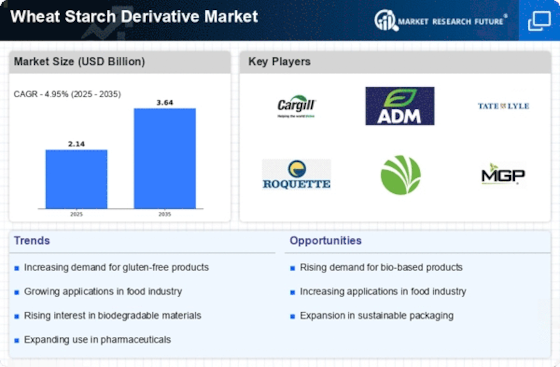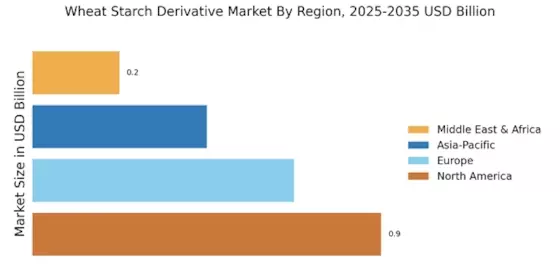Growth in Non-Food Applications
The Wheat Starch Derivative Market is not limited to food applications; it is also witnessing growth in non-food sectors such as pharmaceuticals, cosmetics, and textiles. In pharmaceuticals, wheat starch derivatives serve as excipients, aiding in drug formulation and delivery. The Wheat Starch Derivative Market is expected to reach USD 7 billion by 2025, with starch derivatives playing a crucial role. In cosmetics, these derivatives are used for their thickening and binding properties, enhancing product stability. The textile industry also utilizes wheat starch derivatives for sizing and finishing processes. This diversification into non-food applications is likely to bolster the overall market, as it opens new avenues for growth and innovation.
Sustainability Trends in Agriculture
The Wheat Starch Derivative Market is increasingly influenced by sustainability trends in agriculture. As consumers and manufacturers alike prioritize eco-friendly practices, the demand for sustainably sourced wheat starch derivatives is on the rise. This shift is prompting producers to adopt sustainable farming practices, which not only benefit the environment but also enhance the marketability of their products. The global market for sustainable food ingredients is projected to reach USD 25 billion by 2027, indicating a growing consumer preference for products that align with sustainability values. Consequently, the wheat starch derivative market is likely to experience growth as stakeholders respond to these trends, ensuring that their offerings meet the evolving expectations of environmentally conscious consumers.
Increasing Application in Food Industry
The Wheat Starch Derivative Market is experiencing a notable surge in demand due to its extensive applications in the food sector. Wheat starch derivatives are utilized as thickeners, stabilizers, and emulsifiers in various food products, including sauces, dressings, and baked goods. The market for food starches is projected to reach approximately USD 20 billion by 2026, indicating a robust growth trajectory. This increasing application is driven by consumer preferences for natural ingredients and clean label products, which are perceived as healthier options. As manufacturers seek to enhance the texture and quality of their offerings, the demand for wheat starch derivatives is likely to continue its upward trend, thereby solidifying their role in the food industry.
Rising Health Consciousness Among Consumers
The Wheat Starch Derivative Market is significantly influenced by the rising health consciousness among consumers. As individuals become more aware of the nutritional content of their food, there is a growing preference for products that are perceived as healthier and more natural. Wheat starch derivatives, often viewed as a healthier alternative to synthetic additives, are increasingly favored in various food formulations. This trend is reflected in the increasing sales of clean label products, which are projected to reach USD 180 billion by 2025. Consequently, manufacturers are reformulating their products to include wheat starch derivatives, thereby driving demand in the market. This shift towards health-oriented products is expected to sustain the growth of the wheat starch derivative market.
Technological Innovations in Starch Processing
The Wheat Starch Derivative Market is benefiting from technological innovations in starch processing techniques. Advances in enzymatic and physical modification methods have enhanced the functionality and versatility of wheat starch derivatives. These innovations allow for the production of customized starches that meet specific application requirements across various industries. For instance, the development of high-performance starches that exhibit improved solubility and stability is gaining traction in the food sector. The Wheat Starch Derivative Market is anticipated to grow at a CAGR of 5% through 2026, indicating a favorable environment for the wheat starch derivative market. As technology continues to evolve, it is likely to further enhance the appeal and utility of wheat starch derivatives.


















Leave a Comment